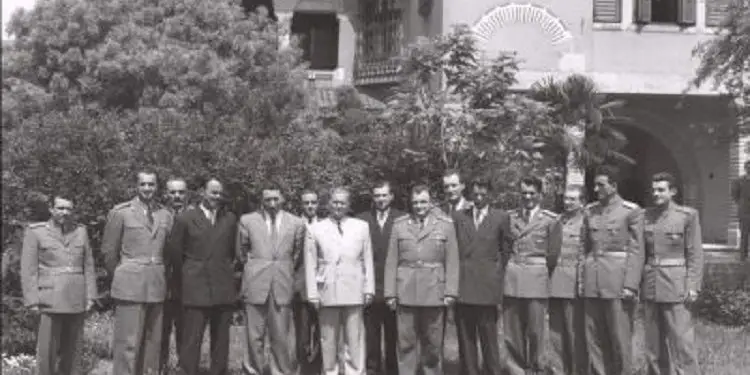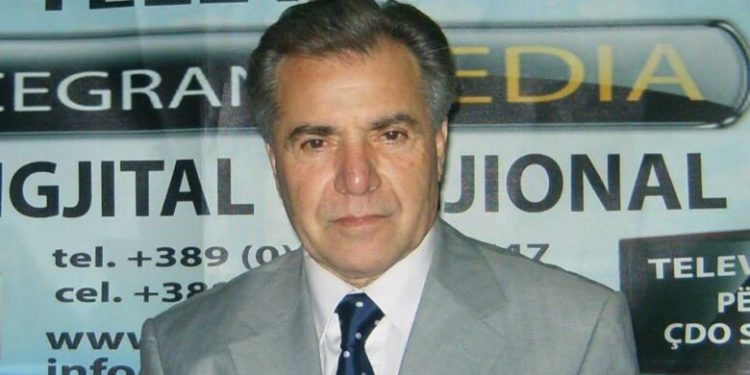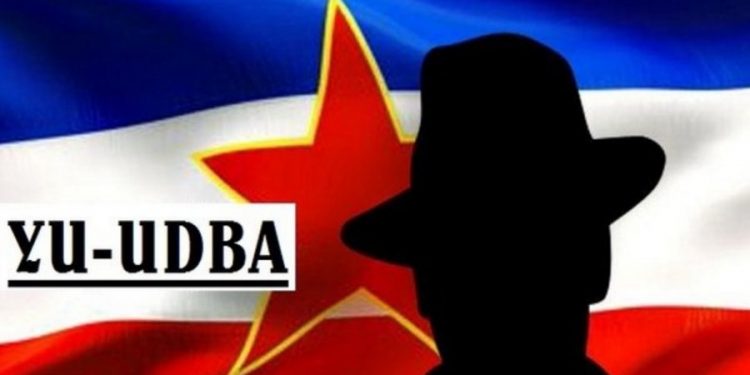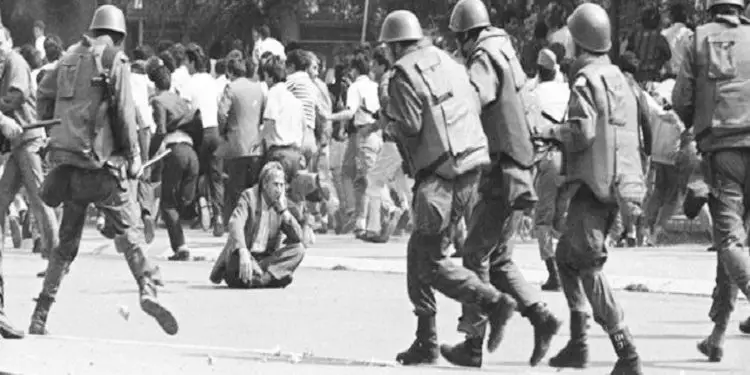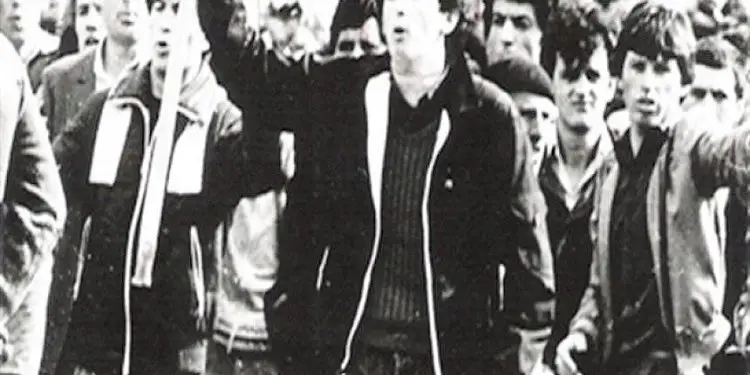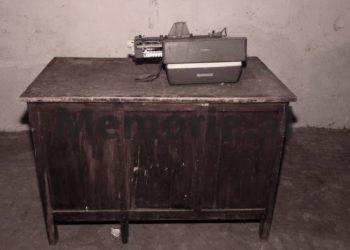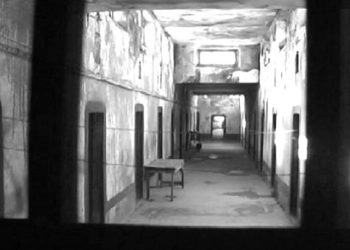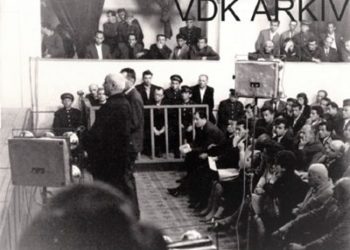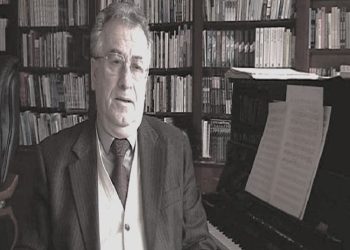Testimony of a Judgment Dead Before Justice
By Nafi Çegrani
(The Zenica Trial: A Fabricated Political Case in Yugoslavia in 1981)
Memorie.al / At a time when humanity is trying to build bridges of understanding in an increasingly troubled world, in the heart of the Balkans, the ghosts of the communist system’s past are still being resurrected with a language that knows no reason. Or, there is still silence from the courts and justice – from those who should think carefully before they speak and deliver verdicts, instead of holding onto their rusty, guilty minds, without a shred of human conscience. And when a series of orchestrated trials of their savage, Bolshevik style, with fabricated charges, are still not condemned as such, but remain hidden and locked away in drawers, in silence and unexamined by the eye of justice – or perhaps because they were created under the secret orders and plans of the fascist and chauvinistic regime of a time when the UDB and its chauvinistic and fascist underground leaders were in control, and are still tolerated – it becomes a collective danger, especially to justice, coexistence, security, and democracy itself.
This climate is not new for Albanians living in their lands in this corner of the Balkans. We have gone through waves of historical denial, displacement, and exile as a people and as a nation, facing the storms of institutional discrimination in communist Yugoslavia, and even continuous attempts to devalue our collective identity. We have endured the storms of centuries, we have preserved our language, culture, memory, and roots, our nobility and generosity toward others, but we cannot remain silent when everything human is once again called into question by the primitive spirit of chauvinism and hatred from those who do not even know themselves. Those who do not build history on human values try to show the force of violence and crime, of hatred and humiliation toward others, especially toward us Albanians, because they have this practice from their institutional communist past, through the humiliation of the other.
These organized and inherited insults and threats from the monist system and the past are a moral crime; they are a denial of the very human right and justice. Even what has been done for years and decades by those who are supposed to administer justice, like the courts (I have the Zenica case from 1981 as an example), for decades they have been and remained the rusty pawns of that malevolent communist system, just like the Kapetanovićs and Babovićs, Mustaćs and Berbatovićs, Bradarićs, etc., who, under secret orders and plans, sentenced innocent people to severe prisons. Why is this, indeed?
This is an act that demands political, legal, ethical, and social condemnation. Silence in the face of this phenomenon is not neutrality but complicity. We Albanians do not ask for mercy. We ask for justice. The events I recount did not happen in the darkness of past centuries but in Europe from 1980 and the beginning of 1981 and onwards, where we suffered terribly in a state that claimed to be “socialist and fraternal.” But, unfortunately, we feel and face the storms of injustice even today, with our eyes turned toward democratic Europe and the EU.
This is my confession, the confession of a man sentenced to death by firing squad, in the right of God, and for years and years, I have been targeted, surrounded by a cold-blooded machine: investigators, prosecutors, judges, and ministers, all linked in a chain of orders from the interrogation cells of Zenica prison, where I experienced hell with blood-bound handcuffs and chains, to the offices in Belgrade and the cabinets of federal officials… In the early 1980s, Albanians in Yugoslavia faced a reality where their nationality was the very proof of guilt.
My refusal to be a tool for projects aimed at the assimilation of Albanians and the erasure of their identity put me in the sights of the UDB and SDB. Conflicts with circles in Belgrade and Skopje made me an “internal enemy” or a “CIA agent,” several years before my criminal case was opened, especially after my return from the USA, where I had escaped a long time ago. After Tito’s death and the start of the demonstrations in Kosovo, the winds of an ice storm began to strike my forehead and the soul of my family and me.
…Escaping to the USA did not save me. From behind the scenes, the secret services built absurd accusations – they declared me a “CIA agent,” a fabrication orchestrated to politically stigmatize me and justify my elimination as an undesirable figure. The accusations were not just a blow against me, but part of a broad policy to create fear and destroy any individual who dared not to bow down.
Arrest and Transfer to Zenica
The year 1981 – the Albanian demonstrations in Kosovo shook the foundations of a state that had forgotten that peoples cannot be imprisoned forever. In this climate of repression, I was arrested on fabricated charges for a “murder” that had never happened. From the cell in Bugojno, where its enraged police treated me as a criminal before judging me, I was transferred to the Zenica investigative prison – a place that prisoners called “living graves.”
The Investigators and Police
Budo Nikica – the investigative judge who legitimized torture as a “procedure.”
Ante Bernada and Stipe Grabovac – inspectors of the SPB-Bugojno, executors of physical and psychological violence.
Fikret Bradariq – chief investigator, a personal friend of Zdravko Mustać in Belgrade, who coordinated the trial’s script.
The Judges and Prosecutors
Sulejman Kapetanović – the main judge, known for political trials against Albanians.
Tihomir Babović – the co-judging judge of the judicial farce.
Mensur Hoxhiq – a prosecutor who used the indictment as a political instrument.
Ante Varunek – a judge of the Supreme Court who sealed the political decision.
Mirko Vlajsavlević – a rare exception, whose decision had a more just and legally accurate basis!
The Masterminds from Behind the Scenes
Duško Zgonjanin – Minister of Internal Affairs.
Nikolla Ilievski – head of the SDB in Skopje.
Zdravko Mustać – high official of the federal SDB in Belgrade.
Mirko Bunevski – an official of the federal SDB.
Stane Dolanc – federal Minister of Internal Affairs and a key figure in Yugoslav security.
Branko Mikulić – President of the Presidency of Bosnia and Herzegovina, directly informed about my case. This was the vertical chain of persecution: from the investigators in the cells of Zenica and Bugojno to the federal offices in Belgrade, where reports on the progress of my case were passed as strategic materials.
***
The courtroom was not a place of justice but an arena where the law was dead. Judge Kapetanović brought Vahedin Ramadani into the courtroom, his face swollen and bruised from the beatings. With a trembling voice, he repeated the words learned under torture: “Vahedin, tell Nafi to his face everything you told us!” He knew he was lying; he knew he was a tool of violence. But for them, this was “evidence.” I rejected every accusation, declaring that the process was a farce based on torture, provocation, and political orders.
My trial violated the principles guaranteed by: Article 3 of the Universal Declaration of Human Rights – the right to life, liberty, and personal security, Article 5 – the prohibition of torture and inhuman treatment, Article 6 of the European Convention on Human Rights – the right to a fair trial, the UN Convention Against Torture – the absolute prohibition of using evidence obtained through torture.
In the isolation cell, with a dim light that flickered like the last breath of hope, I realized that a man is small in the face of darkness, but he becomes great when he keeps the light of his conscience lit. I decided not to be broken. I have asked for forgiveness even when I was not guilty – not out of weakness, but out of the belief that nobility does not need victory to be righteous. Where does justice remain, indeed? My story is not unique. It is part of a dark chapter in Yugoslavia’s relations with Albanians. Forgotten injustice is repeated injustice. Therefore, this document is not just a personal memory but a call for the truth not to be hidden and for the responsible parties not to be forgotten. Even when legal justice fails, the court of history remains – and it cannot be corrupted.
The Delayed Legal Path (Documentation & Reopening)
Document everything, including all court decisions, charges, testimonies, and any evidence that points to fabrication or procedural violations.
Request the reopening of the case based on violations of fundamental rights, especially if you have new evidence or testimonies. Use lawyers specialized in human rights and fabricated political cases. Although Strasbourg is slow and often formalistic, a well-prepared file by a reliable team increases the chances.
The Historical-Public Path (Truth as Defense)
Since formal justice often fails, the public proclamation of the truth is another form of defense. You can prepare a book, documentary file, or articles where you present your case in the context of the UDB/SDB’s actions against Albanians – this way; it does not remain just a personal case but becomes part of a larger history of repression. Collaboration with investigative journalists, historians, and independent researchers can help you gain public space that you did not have in the courts.
The Alternative International Path (Not Just Strasbourg)
There are other international organizations besides the Strasbourg Court: the UN Human Rights Committee, OSCE, Amnesty International, and Human Rights Watch. These are not courts, but the reports and public pressure they create can force a reaction from national authorities. I am writing with great and full conviction and courage for justice, and I DO NOT WANT TO LEAVE THE CASE solely in the hands of the courts. I am seeking the clarification of the legal and divine truth, because everyone and every person who has a human soul, or especially those who lead institutions, relevant bodies, and courts, should bring this case back onto the tracks of law and justice. From a closed case of a “forgotten victim,” it can become an exemplary case that shows the face of the repressive mechanism of the former Yugoslavia and its consequences to this day.
This makes it impossible to remain silent. That is why I write, I do not remain silent, because I am on the true path of justice. This is how I act with soul and heart, with a healthy mind and pride as an Albanian, because I have faith and conviction in the people of justice, and if I do not achieve full legal justice, I will achieve moral and historical justice, which is sometimes the only form that will survive even after my death.
The Atmosphere of the Time…
(What should be kept in mind): A description of the political reality of Yugoslavia in the years before and after Tito’s death?
The situation of Albanians and the functioning of the courts as political tools. The emphasis: the court was not a temple of law but a stage for farces. My escape, the causes and reasons for my flight to the USA, and the cross-border persecution. The absurd accusations (“CIA agent”) and their orchestration by the UDB/SDB. The arrest in 1981 in the climate of the Albanian demonstrations. The transfer to Zenica, the infamous prison with “living graves.” A description of the judicial panel: names, political connections, and secret services. The scene with Vahedin Ramadani as proof of torture and the use of violated witnesses. Your public reaction in the courtroom: rejection of the charges and denunciation of the farce.
Fundamental Human Rights Violations
Listing of the violated articles according to the Universal Declaration, European Convention, and Convention against Torture. Arguing why the process had no legal basis. Resistance and Dignity: The experience in the isolation cell and reflections on the light of conscience. The determination not to be broken, despite torture, humiliation, and isolation. The principle of forgiveness as a sign of nobility, not weakness. The various court decisions: injustices and exceptions. The role of Judge Mirko Vlajsavlević as an example of a more just decision. Placing the case in the context of the systematic persecutions of Albanians by the UDB/SDB. Forgotten injustice as repeated injustice. The need for public and international documentation of such cases. The value of historical testimony in the absence of legal justice. The reader (jurist, historian, or general public) easily follows the chronology and logic of the event. The legal and moral arguments are clearly separated. The story becomes stronger as documentation for public and international use.
…The darkest structures of Yugoslav nationalism had marked me as an “internal enemy” long before my arrest. The reason? I refused to become a tool in the projects for the extinction of the Albanian identity. Conflicts with circles in Belgrade and Skopje put me on the black list of the UDB and SDB. When I escaped to the USA, I thought I had left their clutches behind. But the system follows you like a shadow: the accusations of being a “CIA agent”- an absurd fabrication -were used to discredit me and legitimize my political elimination. In 1981, amidst the turmoil of the Albanian demonstrations in Kosovo, I was arrested on fabricated charges for a “murder” that had never happened. With my hands bound, they took me to the Zenica investigative prison – the place that prisoners called “living graves.” / Memorie.al




